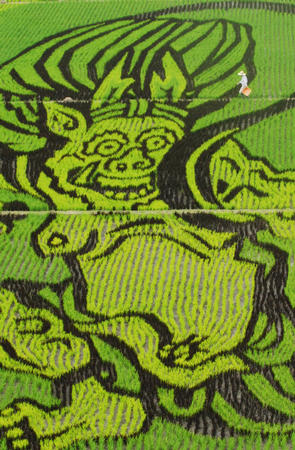
On August 25, Toyota Roof Garden (a subsidiary of the Toyota Motor Corporation) began taking orders for its TM9 turf mats, modular grass tiles developed specifically for converting rooftops into fields of green. In addition to providing an extra layer of thermal insulation to a building, a grassy rooftop can also be used as a putting green, says the company.
The mats act as a foundation upon which to grow Toyota's TM9 brand of Korean velvet grass (korai shiba), which only needs to be cut once a year (as opposed to 3 to 4 times for other varieties) due to its slow growth. Each 50 x 50 cm (20 x 20 in.) mat is 6 cm (2 in.) thick. Setting up a field is fast and easy -- just arrange the mats where you want them and voila, your grass is ready to be enjoyed.
The mats also include space for water tubes that can be used as an automated irrigation system. Water flows through the tubes into a series of channels beneath the grass, providing an even supply of moisture to the roots. Each square meter (10 sq.ft.) needs 17 liters (4.5 gallons) of water every 3 days.
For the time being, TM9 turf mats are made to order. At 5,000 yen (US$43) per square meter (10 sq.ft.), the company aims to sell 3,000 square meters (30,000 sq.ft.) in 2006.
Green rooftops provide thermal insulation for buildings and can help combat the urban heat island effect. The annual Japanese market for rooftop and wall gardening products is expected to grow to between 10 and 15 billion yen (US$90 to 130 million) in the near future.
[Source: Fuji Sankei]


 A mutant tomato with a face resembling a Chinese lion mask was harvested from a field in the city of Yahata in Kyoto prefecture. The common momotaro tomato is 3 times the normal size, measuring 10 cm in diameter and weighing 150 grams.
A mutant tomato with a face resembling a Chinese lion mask was harvested from a field in the city of Yahata in Kyoto prefecture. The common momotaro tomato is 3 times the normal size, measuring 10 cm in diameter and weighing 150 grams. 
 A giant image of Raijin, the God of Thunder, has appeared in a rice field in the village of
A giant image of Raijin, the God of Thunder, has appeared in a rice field in the village of  With the arrival of Japan's rainy season, a mysterious type of green, glow-in-the-dark mushroom begins to sprout in Wakayama prefecture. The Mycena lux-coeli mushrooms, known locally as shii no tomobishi-dake (literally, "chinquapin glow mushrooms"), sprout from fallen chinquapin trees. As they grow, a chemical reaction involving luciferin (a light-emitting pigment contained within the mushrooms) occurs, causing them to glow a ghostly green.
With the arrival of Japan's rainy season, a mysterious type of green, glow-in-the-dark mushroom begins to sprout in Wakayama prefecture. The Mycena lux-coeli mushrooms, known locally as shii no tomobishi-dake (literally, "chinquapin glow mushrooms"), sprout from fallen chinquapin trees. As they grow, a chemical reaction involving luciferin (a light-emitting pigment contained within the mushrooms) occurs, causing them to glow a ghostly green. Japanese scientists researching the prospects of long-term human settlements on Mars are dreaming up ways to address the challenges of Martian agriculture. At a recent meeting of the
Japanese scientists researching the prospects of long-term human settlements on Mars are dreaming up ways to address the challenges of Martian agriculture. At a recent meeting of the  A daikon radish with a distinctly human shape is the talk of the town in Sasamicho, Wakayama prefecture.
A daikon radish with a distinctly human shape is the talk of the town in Sasamicho, Wakayama prefecture.